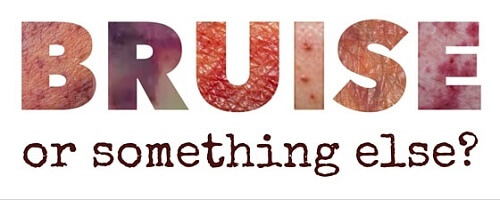If you’ve ever noticed bruise-like spots on your skin that aren’t bruises, they may be skin lesions. So what might look like a bruise at first glance could really be a suspected deep tissue injury, purpura . . . or something else. Do you know the difference? We break down what a bruise is, petechiae vs purpura, deep tissue injuries, and more.
If a picture is worth a thousand words, then in the world of wound care, the same can be said about the appearance of a lesion – where the blood has escaped the vessels and entered the skin. By paying close attention to the color and texture, you can determine if it is more than a simple bruise.
Knowing what to look for – and getting the bigger picture – helps us conduct better assessments. What appears at first glance to be a standard bruise could actually be anything from purpura or petechiae, to an ecchymosis or hematoma. Or wait . . . is it a suspected deep tissue injury (sDTI)?
These terms are often used interchangeably, but within wound care, clinicians define them more precisely. Confused? Don’t worry, we’re here to help!
What is a Bruise?
A bruise (also known as a contusion), is a leakage of blood from the vessels into tissues, and is always the result of blunt force trauma. Keep in mind that “blunt force” doesn’t necessarily mean your patient has been in a fist fight or hit with a baseball bat. The bruise can be the result of something as simple as bumping into furniture.
So what is a bruise?
Here’s how to tell the difference between a bruise and a skin lesion:
- Bruises typically resolve within two weeks.
- They are initially a dark maroon or reddish color (because the blood is oxygenated).
- As the bruise ages, it progresses through the colors of a ripening banana – from green to yellow and then brown – before fading away. Note: these colors will be less obvious with darker skin, so as you make your assessment, compare the site with a symmetrical area, if possible.
- The skin is always intact.
- The damage can be superficial, it can be deep, or it can be a combination of the two.
- The tissues may be painful and swollen, and there may be a localized temperature increase due to the inflammation.
Hematoma
A subdermal hematoma is a collection of blood in the skin, often clotted, bulging or mass-like. It may be in just the epidermis and dermis, or down into the subcutaneous tissue. A hematoma is not the same as a bruise, though you may find a hematoma within a bruise. The most common cause of a hematoma is injury or trauma to the blood vessels.
Petechiae vs Purpura vs Ecchymosis: Difference from Bruises
Purpura consists of red or purple lesions that are similar to bruises, in that they are blood added to the skin tissues. However, purpura spots are not the result of blunt force trauma. Instead, they are caused by either an inflammatory skin disease or a vascular problem. In addition:
- Purpura spots don’t blanch when pressed.
- There is usually no kind of pain associated with purpura.
- Purpura may be palpable (that is, you can feel a rash-like texture with your fingers) or unpalpable.
- Unpalpable purpura comes in different types, including petechiae, which are flat purpura spots under 3 mm. These pinpoint-sized spots may be quite difficult to identify in darker skin.
- Flat purpura spots that are larger than 5 mm are called ecchymosis. These spots tend to be irregular in shape (ranging from a dark maroon to a purple), and can be seen on the skin or in the mucus membranes.
It’s important to note that ecchymosis and bruising are not the same thing, though you may hear some clinicians use these terms interchangeably. Again, ecchymosis is a kind of purpura, and is not caused by blunt force.
Suspected Deep Tissue Injury
Suspected Deep Tissue Injuries (sDTIs) also share some qualities with bruises in that they are non-blanchable, intact, and appear in similar colors – purple or maroon. Alternately, they may be a blood-filled blister.
But here’s the key difference: sDTIs are due to damage from pressure or shear, and not blunt force. Therefore, you’re more likely to find them over a bony prominence and in patients with a history of immobility. The most common site for an sDTI is the heel.
When you touch the tissue of sDTIs with your fingertips, it could be painful, firm, mushy, boggy, and warmer or cooler compared to adjacent tissue. It’s important to use palpation on all dark-skinned patients on high-risk areas, because visual assessment cannot be trusted. Swift identification of sDTIs is important because unlike bruises, which will resolve on their own, sDTIs can deteriorate rapidly, exposing additional layers of tissue despite treatment or offloading.
Do you know the difference?
Now that you’ve learned about the differences between bruises, sTDIs and other similar skin conditions, what do you think? Have you been able to distinguish the true identity of patient lesions in the past, or has it been difficult to properly assess them? Has your facility emphasized the need to distinguish between these types of lesions? And which type do you find the most difficult to identify? We’d love to hear more about your experiences – please leave your comments below.
Wound Care Education Institute® provides online and onsite courses in the fields of Skin, Wound, Diabetic and Ostomy Management. Health care professionals who meet the eligibility requirements may sit for the prestigious WCC®, DWC® and OMS national board certification examinations through the National Alliance of Wound Care and Ostomy® (NAWCO®). For more information see wcei.net.
Want to learn more about Skin Lesions & Wound Care? Our Skin & Wound Management course can help!
Learn MoreWhat do you think?

